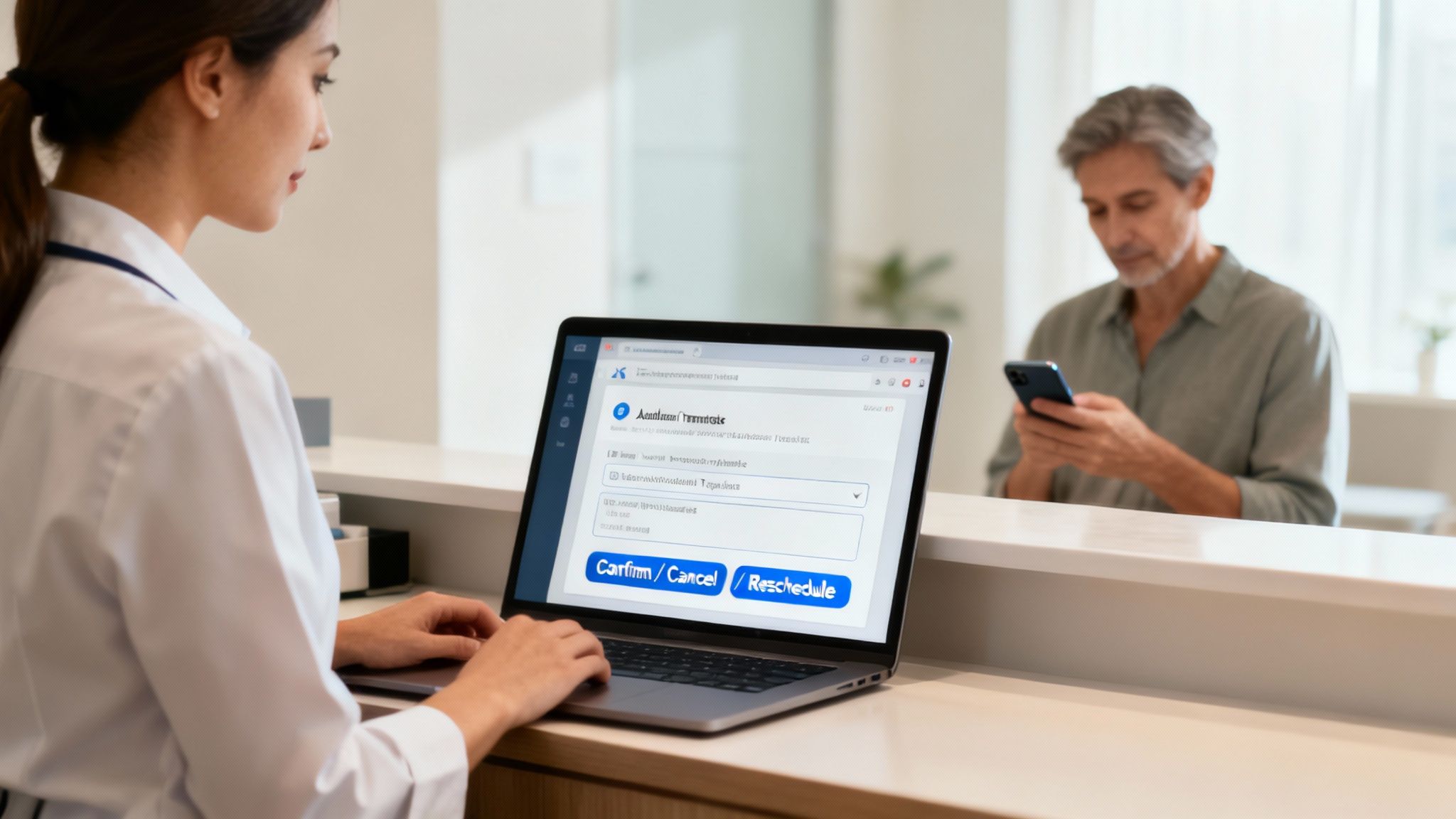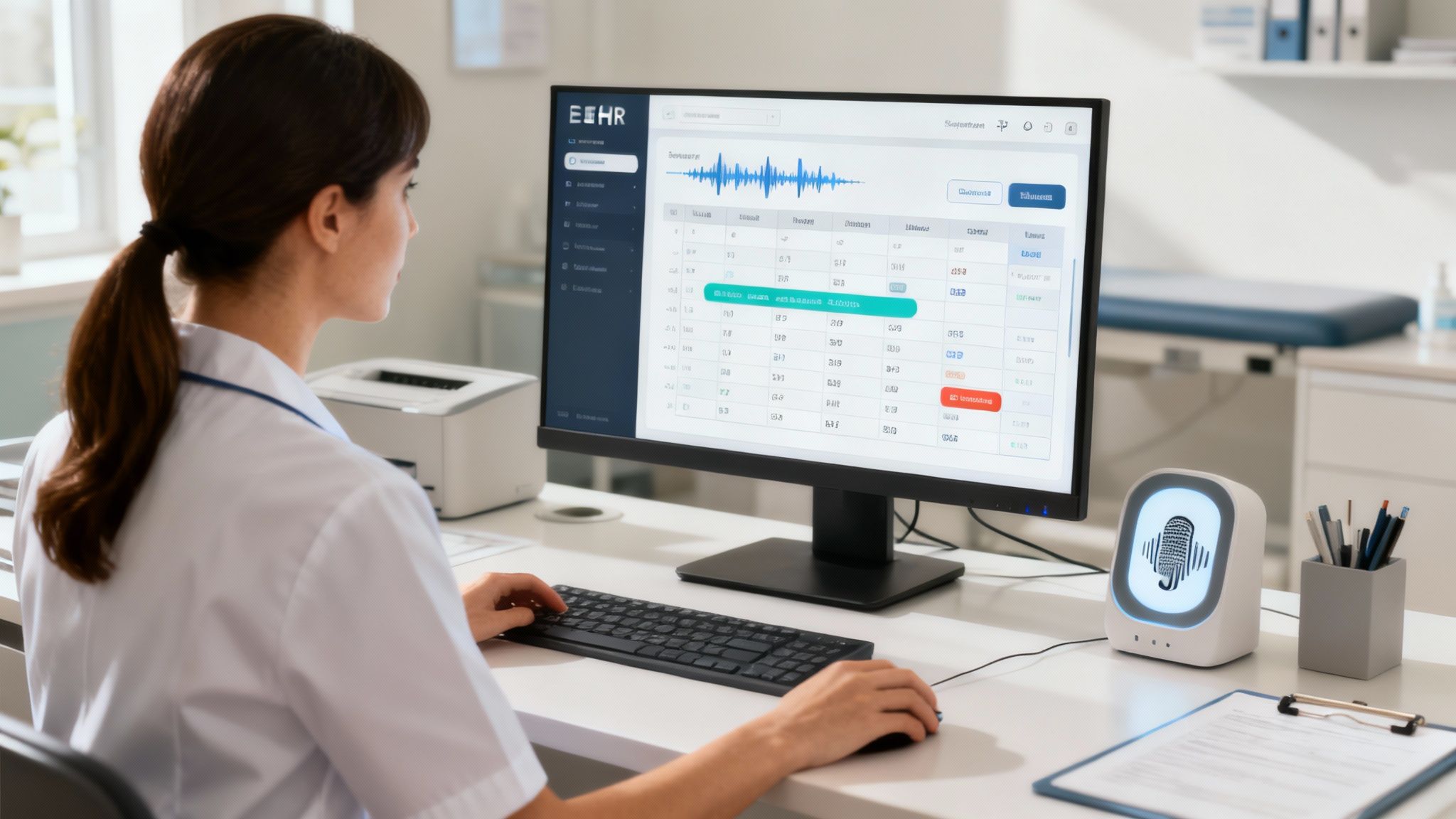Tackling patient no-shows is far more complex than just sending a few extra reminders. It requires a comprehensive, three-pronged approach that addresses the root causes of missed appointments. First, you must diagnose why patients are failing to show up. Second, you need to establish clear, fair expectations with a robust appointment policy. Finally, you must leverage smart, multi-channel communication to keep appointments top of mind and make rescheduling effortless. By integrating these diagnostic, policy, and communication strategies, you can create a reliable system that significantly improves your schedule's predictability, enhances patient access, and protects your bottom line.
1. Find the Real Reasons Patients Miss Appointments
Before you can effectively solve your no-show problem, you must move beyond assumptions and begin a thorough diagnostic process. It’s easy to attribute all no-shows to simple forgetfulness, but the reality is often far more nuanced and deeply connected to a clinic's unique patient demographics, operational workflows, and communication practices. A generic, one-size-fits-all solution is destined to fail because it doesn’t address the specific root causes driving no-shows in your practice.

Your first and most crucial step is to delve into your own data. Your practice management software (PMS) or Electronic Health Record (EHR) system is a goldmine of actionable insights waiting to be uncovered. Don't just look at the high-level no-show percentage; segment and analyze the data to identify meaningful patterns.
Uncover Patterns in Your Data
To truly understand the problem, you need to get granular. By asking targeted questions about your missed appointments, you can uncover subtle trends that would otherwise go unnoticed. This analytical rigor is the foundation of an effective reduction strategy.
- Which providers experience the most no-shows? A high rate for a specific clinician could indicate issues with patient-provider rapport, scheduling templates, or consistently long wait times associated with that provider.
- Are certain appointment types more prone to being missed? It is common for new patient consultations, annual wellness visits, or preventative screenings to have higher no-show rates compared to urgent follow-ups for acute conditions.
- Do you observe spikes on specific days or times? Many practices struggle with Monday mornings, as patients may forget over the weekend, and Friday afternoons, when the pull of the upcoming weekend is strong.
Answering these questions transforms a vague, overwhelming problem like "our no-show rate is 18%" into a specific, manageable one, such as, "Dr. Smith's new patient appointments scheduled on Friday afternoons have a 30% no-show rate." This specificity gives you a clear target for intervention.
Gather Qualitative Insights from Your Team and Patients
While data reveals the "what" and "when," your team and patients provide the critical "why." Your front-desk staff, in particular, are on the front lines of patient interaction and often possess invaluable qualitative insights into the real-world barriers patients face.
Schedule a brief team huddle dedicated to this topic. Ask your staff for their unfiltered observations and anecdotal evidence. What are the most common reasons or excuses they hear when patients cancel last-minute or simply fail to appear? They might highlight operational friction you hadn't considered, such as confusing pre-appointment instructions, difficulty navigating your phone system to reschedule, or a lack of available parking. Exploring various healthcare communication strategies often reveals simple operational tweaks that can yield significant improvements.
You can also gather feedback directly from the source. When a patient no-shows, instruct a staff member to make a gentle, non-accusatory follow-up call. The key is to frame the call as a wellness check, not a reprimand. A simple script like, "Hi, this is Sarah from Dr. Adams' office. We missed you for your appointment earlier today and I just wanted to call to make sure everything is okay," can open the door to candid and incredibly useful feedback.
Key Takeaway: The most effective diagnosis combines quantitative data from your EMR with qualitative, real-world insights from your staff and patients. This creates a complete, 360-degree picture of your no-show problem, enabling you to design solutions that address the actual, underlying issues.
This table outlines common no-show drivers and key questions to guide your internal investigation.
| Potential Driver | Key Diagnostic Questions to Ask |
|---|---|
| Simple Forgetfulness | Are our reminder cadences and channels (SMS, email, voice) optimized for our patient population? |
| Logistical Barriers | Do patients frequently mention challenges with transportation, childcare, or obtaining time off from work? |
| Financial Concerns | Are we transparent about co-pays, deductibles, and out-of-pocket costs prior to the visit? |
| Communication Gaps | Is it easy for patients to cancel or reschedule? Are our phone lines often busy or understaffed? |
| Poor Patient Experience | Are in-office wait times excessively long? Does one specific provider have a disproportionately high no-show rate? |
| Appointment Lead Time | Is there a correlation between how far in advance an appointment is booked and the likelihood of a no-show? |
Use these questions as a starting point. The answers will illuminate the most impactful areas for change within your practice.
It is also crucial to acknowledge the influence of external factors. A significant body of research shows that socioeconomic determinants of health—such as unstable housing, food insecurity, or low income—are strongly correlated with higher no-show rates. For instance, a 2023 analysis published in a leading medical journal found that patients facing such adversities were up to three times more likely to miss a scheduled medical appointment. Recognizing these external pressures allows you to design a more empathetic, flexible, and supportive system for your most vulnerable patients.
2. Build a Foundation with Clear Patient Policies
Before implementing advanced communication strategies, you must establish a clear and consistent policy framework. Think of your policies as the operational backbone of your scheduling process. Without a well-defined and consistently enforced policy, even the most sophisticated reminder system will ultimately fall short of its potential.
Many practices hesitate to implement firm policies, fearing they might alienate or scare off patients. In my experience, the opposite is true. When policies are communicated with empathy, clarity, and fairness, they send a powerful message: you value the patient's time just as much as your provider's. This mutual respect builds a stronger, more professional relationship from the very first interaction.
Writing a No-Show Policy That Works
An effective no-show and cancellation policy is firm in its requirements but fair in its application. Its primary purpose is not to be punitive, but to educate patients on the significant impact a missed appointment has on the practice's operations and, more importantly, on other patients who are waiting for care.
Ensure your policy is highly visible and easily understandable. Prominently display it on your website's FAQ page, include it in new patient intake forms, and have your staff briefly review it when a patient books their first appointment. Establishing this shared understanding from day one prevents misunderstandings and awkward conversations down the line.
Here are the non-negotiable elements every policy should include:
- The Required Notice Period: Be specific. State clearly whether you require 24 hours or 48 hours notice. This defined timeframe gives your team a realistic opportunity to offer the vacant slot to another patient.
- The Method of Cancellation: Don't create barriers. Specify the approved methods for cancellation. Can patients simply reply to a reminder text? Can they use a patient portal? Or must they call the office? The easier you make it, the higher your compliance rate will be.
- The Consequences of Non-Compliance: Clearly outline the repercussions. Is there a fee? Will a deposit be required for future bookings? In cases of chronic no-shows, could it eventually lead to dismissal from the practice?
A Quick Tip on Wording: Frame your policy around patient access and care, not financial penalties. Instead of a blunt statement like, "You will be charged a $50 fee," adopt a more collaborative tone: "When an appointment is missed without notice, another patient loses the opportunity to receive timely care. To help us provide access to all our patients, a $50 fee may be applied for appointments canceled with less than 24 hours' notice."
This subtle shift in framing transforms a punitive rule into a shared responsibility, fostering patient cooperation rather than resentment.
When to Use Appointment Deposits
Appointment deposits can be a powerful tool for reducing no-shows, but they require strategic implementation. They are most effective in situations where a no-show results in a significant loss of revenue or ties up specialized resources.
Consider requiring a deposit for:
- High-Value or Long-Duration Appointments: This includes surgical consultations, extensive cosmetic procedures, or any visit that reserves a provider's time and specialized equipment for an extended period.
- New Patients: Initial consultations are often longer and more resource-intensive. A small, refundable deposit helps ensure that the individual is serious about establishing care with your practice.
- Patients with a Documented History of No-Shows: If a patient has missed multiple appointments, requiring a deposit for their next booking is a reasonable and justifiable measure to encourage commitment.
If you implement a deposit policy, ensure the payment process is seamless. Integrating an online payment link into your booking workflow is ideal. Always be transparent that the deposit will be applied to the cost of their visit or fully refunded if they cancel within the policy's specified timeframe.
Empower Your Staff with Consistent Workflows
A meticulously crafted policy is rendered useless if it is not enforced consistently by your team. Standardized workflows ensure that every patient receives the same information every time, reinforcing the importance of their appointment commitment.
Train your front-desk staff to discuss your policies with confidence and empathy. They must be able to articulate the why behind the rules—explaining that the policy's goal is to maximize appointment availability for all patients. Provide them with simple scripts and talking points to handle questions or pushback gracefully. This training transforms a potentially negative interaction into an educational opportunity that reduces no-shows and strengthens patient relationships.
3. Design a Reminder Sequence That Actually Works
In today's digitally saturated world, a single reminder call the day before an appointment is no longer sufficient. Patients are inundated with notifications, and a solitary message is easily overlooked, leading to another empty slot on your schedule.
To effectively combat no-shows, you must implement a smart, automated reminder sequence that utilizes multiple communication channels to keep the appointment on your patient's radar. This is not about bombarding them with constant messages; it's about delivering helpful, timely touchpoints that make it almost effortless for them to remember and confirm their visit. This strategic approach frees your staff from the inefficiency of manual phone calls while dramatically increasing the likelihood that patients will arrive as scheduled.

A multi-channel strategy meets patients on their preferred platform, whether that's a quick SMS text, a detailed email, or a voice call.
The Anatomy of an Ideal Reminder Sequence
The most effective reminder sequences are not random; they are strategically designed. Each message is timed and crafted to serve a specific purpose, guiding the patient from initial confirmation to final pre-visit preparation.
Here is a breakdown of a sequence proven to deliver results:
- Immediately After Booking: As soon as the appointment is scheduled, send an instant confirmation via both email and SMS. This provides immediate reassurance and allows the patient to add the event to their digital calendar with a single click.
- One Week Out: An email reminder is ideal at this stage. It serves as a gentle, non-intrusive nudge and provides an opportunity to include links to pre-visit paperwork or your cancellation policy.
- 72 Hours Before: This is the critical point for securing a commitment. An SMS message is the best channel here due to its near-perfect open rates. The primary call-to-action should be a simple request to reply "YES" to confirm.
- 24 Hours Before: This is the final check-in. A second SMS message or a friendly automated voice call is highly effective. This message can also include helpful logistical details, such as a link to a map, parking instructions, or a portal for online check-in.
For any modern practice, automating this sequence is non-negotiable. One systematic review of multiple studies found that clinics using automated reminders reduced their no-show rates by an average of 26%. Given that some practices face no-show rates as high as 33%, an improvement of this magnitude represents a significant win for both revenue and patient access.
Crafting Messages That Patients Actually Read
The timing of your sequence is only half the equation; the content of your messages is equally crucial. Generic, robotic messages are easily ignored. Your communication should be clear, concise, and genuinely helpful, making it incredibly simple for the patient to take the desired next step.
Every message in your sequence must include these core elements:
- Patient's & Provider's Name: Personalization confirms the message's legitimacy and relevance.
- Appointment Date & Time: This is the most critical piece of information. Make it bold and impossible to miss.
- Clear Action Buttons/Links: Eliminate friction. Provide simple, one-click options to Confirm, Cancel, or Reschedule. The easier you make it, the more likely patients are to respond.
For practices using a CRM like Keap (formerly Infusionsoft), this Infusionsoft appointment reminder campaign tutorial provides practical, step-by-step guidance for building these types of automated sequences.
Sample Templates You Can Adapt
Feel free to adapt these templates to match your practice's unique voice and brand.
SMS Template (72-Hour Reminder)
Hi [Patient Name], this is a reminder of your appointment with Dr. [Doctor’s Name] on [Date] at [Time]. Please reply YES to confirm or call us at [Phone Number] to reschedule. Thanks, [Clinic Name].
Email Template (1-Week Reminder)
Subject: Your Upcoming Appointment at [Clinic Name]
Hi [Patient Name],
This is a friendly reminder that you have an appointment scheduled with Dr. [Doctor’s Name] on [Date] at [Time].
To save time at check-in, you can complete your pre-visit forms here: [Link to Forms]
If you need to make any changes to your appointment, you can do so through our patient portal or by calling us directly at [Phone Number]. We look forward to seeing you!
Sincerely,
The Team at [Clinic Name]
These templates serve as a solid starting point. Your patient appointment reminders should feel authentic to your practice. The overarching goal is to be direct and helpful, removing any and all friction that might prevent a patient from either confirming their visit or proactively notifying you that they cannot make it.
4. Use Automation to Reclaim Your Team's Time
Manual appointment management is a significant drain on your team's most finite resource: time. The process of making individual reminder calls, manually confirming appointments, and rescheduling patients is not just inefficient; it's also prone to human error. A single mistyped number or a forgotten follow-up call can directly result in a no-show.
This is where intelligent automation transitions from a "nice-to-have" luxury to an operational necessity. By automating these routine, repetitive tasks, you build a reliable, scalable system that works tirelessly in the background, ensuring every patient receives the right communication at the right time without manual intervention from your staff.

Integrate Reminders with Your EMR
The foundational step in successful automation is integrating your reminder system directly with your EMR or EHR. This bidirectional integration serves as the central nervous system for your entire appointment workflow.
When your systems are synchronized, critical appointment data—such as patient name, contact information, visit time, and provider—flows seamlessly and automatically into your reminder software. This immediately eliminates the risk of manual data entry errors, which are a common and entirely preventable cause of no-shows.
The data flow is a two-way street. When a patient confirms by replying "YES" to an SMS reminder, their appointment status within the EMR can be updated automatically. This provides your clinical team with a real-time, accurate view of their daily schedule without requiring any manual updates from administrative staff. To fully appreciate the power of this integration, it is beneficial to explore the core principles of healthcare workflow automation.
Let AI Handle the Confirmation Calls
While SMS and email are highly effective, some patient demographics still respond best to a traditional phone call. However, this doesn't mean your front-desk staff needs to be tethered to their phones all day.
Modern voice AI assistants are specifically designed for this task. A clinically-trained AI can place hundreds of confirmation calls simultaneously, using a natural, conversational tone that avoids sounding robotic. This technology can ask patients to confirm, offer to connect them to a staff member to reschedule, and even answer basic logistical questions about their appointment.
Expert Insight: Voice AI is a transformative tool for staff productivity. It liberates your team from the monotonous grind of repetitive outbound calls, allowing them to focus on higher-value, in-person interactions, such as assisting a patient with a complex billing inquiry or providing detailed pre-procedure instructions.
This technology ensures 100% call coverage without causing staff burnout. The AI can handle a high volume of calls at once, guaranteeing that no patient slips through the cracks, even on your busiest days.
Empower Patients with Self-Service Tools
One of the most effective strategies for improving show rates is to make it exceptionally easy for patients to manage their own appointments. The more control and flexibility you provide, the more invested they become in honoring their commitments.
Online scheduling tools and patient portals are ideal for this purpose. When a patient can book, cancel, or reschedule an appointment on their own terms—whether it's at 10 PM on a Tuesday or 6 AM on a Sunday—they are far less likely to become a no-show simply because they couldn't reach your office during business hours.
These self-service options create a win-win scenario:
- Enhanced Convenience for Patients: They can manage their appointments 24/7 from any internet-enabled device.
- Reduced Administrative Burden: Fewer routine scheduling calls free up your phone lines and your staff's time for more complex tasks.
- Improved Data Accuracy: Patients enter their own information, which significantly reduces the incidence of scheduling errors.
The operational difference between manual and automated processes is stark.
Manual vs. Automated Appointment Management Tasks
| Task | Manual Approach (Staff Time) | Automated Approach (Tool-Driven) | Key Benefit |
|---|---|---|---|
| Appointment Reminders | Staff member individually calls each patient 1-2 days prior. | System automatically deploys a multi-channel sequence of SMS, email, & voice reminders. | Saves countless hours of staff time and ensures 100% coverage. |
| Confirmations | Staff manually updates the schedule after each phone call. | Patient replies "YES" and the EMR schedule is updated instantly. | Real-time accuracy with zero administrative lag or manual effort. |
| Rescheduling | Patient must call in, wait on hold, and have staff find a new slot. | Patient clicks a link in a reminder to view and select a new time from available slots. | Empowers patients, improves satisfaction, and drastically reduces inbound phone traffic. |
By embracing these automated tools, you are not merely finding a more clever way to reduce no-shows; you are fundamentally re-engineering your practice to be more efficient, resilient, and patient-centric.
5. Train Your Staff and Track Your Progress
Your new policies and automated systems are powerful tools, but their ultimate success hinges on the people who implement them. A brilliant strategy can easily fail if your staff isn't fully trained, confident, and aligned with the new protocols. In the ongoing battle against no-shows, your team is your most valuable asset.

Effective implementation goes beyond distributing a memo. It requires empowering your team with the right language, tools, and a clear understanding of the 'why' behind the changes. When your front-desk staff can explain your no-show policy with empathy rather than sounding like they're reading a script, it fundamentally changes the patient interaction from a confrontational moment to a collaborative one.
Equip Your Team with Scripts and Scenarios
Never leave your team to guess what to say. Provide them with simple, clear scripts for the most common patient interactions they will encounter. This removes ambiguity, reduces stress, and ensures every patient receives a consistent, professional message.
Role-playing is one of the most effective training methods for this. During your next team meeting, practice a few common scenarios. How should they respond when a patient expresses anger about a no-show fee? What is the protocol when someone calls to cancel five minutes before their scheduled appointment? Practicing these conversations builds confidence and muscle memory, enabling your staff to handle real-life situations with grace and professionalism.
Example Role-Playing Scenario
- The Situation: A long-standing patient is upset after being charged their first-ever no-show fee.
- The Goal: Acknowledge their frustration, gently reinforce the policy, and build goodwill by offering a one-time waiver.
- What to Say: "I can certainly understand your frustration, and I apologize for any confusion. Our policy is in place to ensure we can provide timely care to every patient who needs an appointment. Since this is the first time this has happened, I am happy to waive that fee for you as a one-time courtesy. Just for future reference, we do ask for at least 24 hours' notice for any cancellations so we can offer the slot to someone else."
This empathetic, educational approach de-escalates a potential conflict and reinforces the policy in a positive manner.
Establish a Clear Protocol for Repeat Offenders
While empathy is crucial, you also need a firm, documented plan for patients who repeatedly miss appointments. This is not about being punitive; it's about protecting your schedule's integrity and ensuring fairness to the vast majority of patients who adhere to the policy.
A simple, tiered protocol is often the most effective and legally defensible approach:
- First No-Show: A staff member makes a friendly follow-up call. They check on the patient, reschedule the appointment, and gently remind them of the policy.
- Second No-Show: The follow-up call is made again, but this time, the staff informs the patient that a deposit will be required to secure their next appointment.
- Third No-Show: This may trigger a formal letter from the practice manager or physician. The letter should clearly state that continued missed appointments could result in dismissal from the practice, as it compromises the patient's care and prevents others from being seen.
Having this protocol written down and understood by all team members prevents inconsistent enforcement and ensures every patient is treated fairly and equitably.
Track the Metrics That Matter
You cannot improve what you do not measure. To determine if your new strategies are effective, you must consistently track a few key performance indicators (KPIs). This data provides objective proof of what's working and highlights areas that may require further adjustment.
Create a simple dashboard—even a basic spreadsheet can work—and review it on a weekly or monthly basis.
Key Takeaway: Tracking your progress is non-negotiable. It transforms your efforts from guesswork into a data-driven strategy, allowing you to identify what's working and double down on those successful tactics.
Here are the essential metrics to include on your dashboard:
- No-Show Rate: The percentage of total scheduled appointments that were missed without any prior notice. This is your primary metric.
- Late Cancellation Rate: The percentage of appointments canceled with less than the required notice (e.g., 24 hours). This helps you understand if your reminders are prompting action, even if it's late.
- Confirmation Rate: The percentage of patients who respond affirmatively (e.g., reply "YES") to your confirmation messages. A high confirmation rate is a leading indicator of a future drop in your no-show rate.
Once your new strategies are live, effective employee training tracking becomes vital to monitor how well the team is adopting the new workflows. Reviewing this data collaboratively as a team fosters a culture of shared ownership and accountability, making every team member a key stakeholder in solving the no-show puzzle.
6. Frequently Asked Questions
Even with a well-designed strategy, questions and challenges inevitably arise when you begin to change long-standing processes. Here are practical answers to the most common questions practices face when implementing a new approach to reduce no-show appointments.
What Is a Reasonable No-Show Rate for a Healthcare Practice?
While the ideal no-show rate is zero, this is not a realistic goal. A good, achievable target for most outpatient practices is a no-show rate under 10%.
However, this benchmark is not one-size-fits-all. Some specialties, like oncology or surgery, may achieve rates as low as 5%, while others, particularly community health centers or behavioral health clinics serving vulnerable populations, may struggle with rates exceeding 20% due to systemic patient barriers.
The most important metric is your own rate of improvement. If your practice currently has a 25% no-show rate, reducing it to 15% over the next six months is a significant victory. Focus on this internal progress rather than chasing a universal, and potentially irrelevant, benchmark.
Should We Charge Patients for Missing Appointments?
Implementing a no-show fee can be an effective deterrent, but it must be handled with care and transparency. The policy must be communicated clearly and consistently to every patient from their very first interaction. There should be no surprises.
Many practices find success with a "one-time grace" model:
- First Occurrence: Waive the fee. Use the incident as an educational opportunity to gently explain the policy and the importance of providing advance notice.
- Subsequent Occurrences: Consistently and fairly apply the fee as outlined in your policy.
It's critical to remember that the primary goal of the fee is not revenue generation; it is to encourage patients to value their appointment slot and communicate with you if they are unable to keep it.
Before implementing any fee-based policy, it is essential to conduct due diligence. Check your state's medical board regulations and carefully review your contracts with insurance payers. Some payers, including Medicaid in many states, have specific rules that prohibit charging patients for missed appointments.
How Can We Be Firm About No-Shows Without Upsetting Patients?
The key to this delicate balance lies in framing and communication. The policy should always be presented as a shared goal: ensuring that every member of the patient community can access care when they need it. Your tone should be consistently helpful and understanding, never punitive or accusatory.
Instead of using language like, “You will be charged a fee,” shift the focus to the community impact. A phrase such as, “When an appointment is missed without notice, it unfortunately takes away an opportunity for another patient to be seen,” reframes a rigid rule into a matter of shared community responsibility.
Furthermore, make it incredibly easy for patients to comply. If they can cancel or reschedule with a single click in a text message, they are far more likely to do so. This convenience demonstrates that you respect their time and are a partner in their care. This supportive, low-friction approach helps patients feel empowered, not punished.
Finally, when a patient does miss an appointment, the initial follow-up call should always come from a place of genuine concern. A simple, “Hi, this is Maria from the clinic. We missed you today and I'm just calling to check in and make sure you’re okay,” can completely reframe the situation. It reinforces that their well-being is your highest priority and turns a potentially negative event into a positive relationship-building touchpoint.
Ready to transform your practice's efficiency and patient communication? Simbie AI offers a clinically-trained voice AI that automates scheduling, reminders, and patient intake, freeing up your staff to focus on what matters most—delivering exceptional care. Discover how our intelligent solution can help you drastically reduce no-shows and reclaim valuable time.
Learn more and schedule a demo with Simbie AI.

